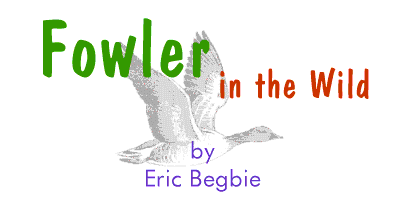

You can now buy a copy of "Fowling in the Wild" which contains the first five chapters plus some additional new material right here:

$9.95 (about £5)
Click on Image to Buy
Introduction
Wildfowling is the pursuit of
wild fowl in wild places. As a shooting sport it is unique in
that success depends more upon the wildfowler's knowledge of the
habits and habitat of his quarry than upon his marksmanship
skills. It is, however, more than just a sport. For those of us
who have responded to the call of a wild estuary, fowling can
become a way of life, a consuming passion which leads us
relentlessly to seek a better understanding of the birds which
inhabit the land and water beyond the tideline.
In the eyes of many folk, the wildfowler must appear to be a very
strange individual. Whether he sets out on a mild October
morning, battles against the gale of a November storm or endures
frozen fingers in late December, the longshore gunner is privy to
a world which is known to only a tiny proportion of 20th-Century
mankind. The marshes and saltings below the sea wall, especially
in mid-winter, constitute one of the last remaining areas of true
wilderness to be found in this crowded country. When the rest of
the nation is asleep, a solitary wildfowler can experience a
communion with nature which is well-nigh impossible in any other
setting.
Not only will he share his world with a rich multitude of
genuinely wild fauna, he will encounter weather conditions which
would send most of his compatriots scurrying for sanctuary. To be
successful at his craft he must learn to read the natural signs -
wind, tide and moon - and become thoroughly familiar with the
topography of his chosen estuary. Dawn and dusk will become as
significant to him as "News at Ten" is to his
city-bound brethren.
All the fowler's senses play their part in revealing to him the
full wonder of this environment. He sees dark storm clouds
scudding across a slowly lightening sky. He hears the ebb and
flow of tides and the myriad calling of dozens of species of
shore birds. He smells the iodine of estuarine vegetation and
tastes the salt spray in the air. All of those combine to fill
out the mental images which colour his anticipation as each new
season draws nigh and they are all part of the memories which
sustain him through the days when his gun is safely locked away
in its cupboard.
Each and every wildfowling expedition is an adventure during
which new problems arise and new solutions are found. In this way
one's knowledge progressively expands with the result that the
novice gradually transforms into an accomplished sportsman. There
are less-experienced wildfowlers and more-experienced wildfowlers
but there are no experts. The span of a human life is too short
for any individual to acquire a monopoly of fowling truth; so let
the man who thinks that he knows it all put away his thigh boots
and take up golf or clay pigeon shooting instead.
It is, therefore, with a sense of humility that this book has
been compiled. In Part I, I have attempted to recount a selection
of personal wildfowling tales which I hope will begin to
illustrate some of the fundamental principles and practices of
the sport. If the accounts of geese flighting over a windswept
foreshore serve to fire the imagination of the novice I will be
well pleased; should more proficient fowlers feel that they have
learned anything new, I shall be delighted.
Part II has been written in more conventional style with a view
to providing a thoroughly up-to-date text to which wildfowlers
may refer for information concerning their quarry, their guns and
cartridges and many other aspects of their craft. Much has
changed in recent years, especially in terms of the legislation
which determines the species which may, or may not, be pursued.
Ethics and codes of conduct are also subject to continuous
updating as fowlers become increasingly conscious of the need to
conserve both quarry and wildfowl habitat. The lead which has
been taken by the British Association for Shooting and
Conservation is one which must be firmly followed by sportsmen
throughout the country.
ERIC BEGBIE